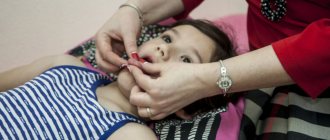One can understand the excitement of parents who suddenly discover that their preschool child speaks some sounds of their native language poorly or not at all. In this case, they are faced with the problem of how to teach the child correct sound pronunciation? Is this acceptable at home? Experts say that parents can do a lot to help a preschooler master correct sound pronunciation. You just need to have certain knowledge: about the causes of poor pronunciation, ways to correct it, ways to teach correct diction.
Causes of poor sound pronunciation
According to speech therapy standards, correct pronunciation should be formed by middle preschool age. However, even older preschoolers experience diction disorders. Experts provide evidence that children find it most difficult to pronounce hissing sounds: sh, zh, ch, shch. Imperfect diction can manifest itself in incorrect pronunciation of a sound, replacing one with another (machine-masyn), or skipping it. Experts identify the main reasons for poor pronunciation. These include the structure of the speech apparatus, insufficient development of phonemic hearing, perception, and the attitude of parents.
Features of physiology
- inactivity of the articulatory apparatus;
- improperly formed bite,
- short frenulum of the tongue,
- high palate.
Immaturity of phonemic perception
- The preschooler does not distinguish individual sounds by ear and replaces them.
Adult misbehavior
- Give the baby a pacifier for too long, especially during the period when speech is developing (early age);
- prolonged use of a pacifier leads to the formation of a malocclusion, which affects the pronunciation of many sounds, especially hissing sounds;
- deliberate distortion of speech by adults in order, in their opinion, to become understandable to the baby;
- dissatisfaction with the preschooler’s diction and the requirement to speak clearly, without teaching correct articulation;
- possible hearing loss not noticed by parents.
Making the sound "ch"
When making the sound “ch,” the speech therapist uses a tricky technique. The child is given the task of pronouncing the combination “at”. But at the moment of pronunciation, the specialist slightly presses the corners of his lips and asks them to move them forward a little. As a result, the baby is able to reproduce the combination “ach”. Regular training helps to easily deliver speech, even in the presence of serious deviations. To increase their effectiveness, the speech therapist constantly talks to the baby, provoking him to pronounce the necessary sounds in a relaxed atmosphere.
How can you test a preschooler’s speech at home?
Having determined that a preschooler cannot speak hissing words, parents should contact a specialist. At home, they can also examine the child’s speech to understand which sibilants are distorted. According to speech therapy rules, the examination begins with a separate pronunciation of a certain sound, then it is pronounced in syllables, words, and only then in sentences. For example:
- The parent, asking the child to reproduce the hissing words sh, zh, ch, shch, pronounces them slowly and clearly. It is more interesting to offer a game form in the form of speech exercises: “The snake hissed: sh-sh-sh”, “The bee buzzed: w-w-w.”
- To check the state of sound in syllables, the baby is encouraged to repeat syllables, for example, shi-zhi, cha-sha, zhu-shu, chu-shu, ash-azh, ach-ashch, cabbage soup, chuh, shoo, whack. In this case, the sounds being tested must be at the beginning, middle, and end of the syllable.
- The next step is to check the pronunciation of sounds in words. For interest, pictures are used where objects are drawn for a given sound (cone, giraffe, hut, teapot, pike and others). In this case, you can use speech therapy visual material, or you can choose pictures in children’s books with your child. The main thing is that they comply with certain rules: hissing words must sound clearly in words, stand at the beginning of the word, the middle, the end (fur coat, car, reed). Using the same principle, words with other hissing words are selected: beetle, gun, skis, etc. It would be good if the examination took place in the form of game exercises. For example, “How to call it affectionately (bird-bird, goat-goat, beetle-bug, winter-winter, sun-sun)? »
- The last stage involves checking the sound in a sentence in which several words with the sibilant being tested are selected. Pure sayings serve this purpose well, for example, “Hush, mice, don’t make noise! Don’t wake up the cat!” Classic tongue twisters are suitable for examining hissing ones: “Sasha was walking...”, “Cuckoo cuckoo...”
Important! When examining a child, you need to try to determine the cause of incorrect pronunciation in order to understand what influenced the distortion of diction.
Why do you have problems pronouncing sibilants?
Certain areas of the brain are responsible for the process of speech development. If their work is disrupted, difficulties arise with the pronunciation of individual sounds. In most cases, the problem is caused by birth injuries. Of particular danger are displacements of the skull bones of the occipital part or vertebrae. As a result, blood circulation in the head area slows down. Brain cells do not receive the required amount of oxygen, which leads to their destruction.
An injury received during childbirth can also provoke pinching of the hypoglossal nerve or disturbances in the associative neural connections of the auditory analyzer. This affects the ability to recognize and reproduce oral speech. For the correct pronunciation of individual sounds, the chewing and facial muscles are no less important. In some cases, speech development in children is slowed down due to injuries received after birth (falling from a sofa, hitting the back of the head, etc.).
The order of setting hissing
If a child suffers from poor pronunciation of only a specific hissing sound (sh, ch, zh, sch), it is clear that work needs to be done on producing one sound. But, as a rule, preschoolers experience distortion in the pronunciation of several sibilants at the same time. Then it is important for parents to know which sound to start with first. Experts determine the appropriate order and warn that each sound must be played individually, starting with the most accessible, gradually moving on to more complex ones. According to speech therapists, the order of production of several sounds depends on the physiology of preschool children: first the hissing sh is placed, then zh, then ch and shch. However, there may be changes in the sequence of placement, since everything depends on individual characteristics, which only a specialist can determine.
Diagnostics
Speech is formed between 3 and 5 years. If problems arise, parents need to take their child to a speech therapist. Diagnosis by a specialist is carried out in a playful way. The doctor determines which sounds the child has problems pronouncing. A visual examination of the articulatory apparatus is also carried out. This includes an examination of the oral cavity. The structure of the jaw, tooth, lips and palate are assessed. During the examination, the child is asked to do the following:
- attempts to reach the chin and nose with the tongue;
- moving the tongue from the left side of the mouth to the right, periodically changing the rhythm of movements;
- pushing the lower jaw forward and then back;
- clicking the tongue;
- the formation of a tube from the lips after they are stretched into a smile.
How to properly work on developing sounds?
When setting up hissing sounds, the help of a speech therapist is undoubted. Only a specialist will professionally examine speech, identify violations and offer recommendations for correcting them in home exercises. This needs to be done as quickly as possible, since pronunciation problems interfere with children’s communication, slow down their preparation for literacy, and contribute to the emergence of related problems, for example, psychological complexes, which will have to be eliminated in the future.
Speech therapists note that often the problem when pronouncing hissing words is that the child cannot properly control the speech apparatus. That is why work on each sound must begin with articulatory gymnastics. It is performed using a mirror to see and understand the work of the jaw and oral cavity. In the future, this will have a positive effect on improving phonemic hearing, and therefore on sound pronunciation.
The first stage of working on hissing is preparatory, during which special exercises should be performed (for breathing, lips, tongue). They will help you practice precise movements of the articulatory apparatus and prepare to produce certain sounds. They are performed in the form of game exercises that are easy to do at home.
How to teach a child to say the letter “sh”
Young children often have problems pronouncing hissing sounds. Doctors have identified several possible reasons for this phenomenon. The most common of these is incorrect articulation. It represents a certain position of the tongue during pronunciation. Other reasons include:
- Incorrect pronunciation of sounds by parents. The child pronounces them as he hears them from others.
- Limitation of motor activity of the tongue due to a shortened hyoid frenulum.
- Disturbances in the functioning of the hearing aid.
- Anomalies in the structure of the teeth and jaw.
Initially, the cause of a mechanical nature should be eliminated. If the problem is a short frenulum, it is trimmed. It is important to pay attention to your child's bite. In case of deviations, appropriate measures are taken. In other cases, a set of exercises helps to improve speech.
Stage 1. Breathing training
Articulation gymnastics involves breathing training, practicing lip and tongue movements. For her, parents can use generally accepted speech therapy games, or they can come up with similar ones themselves. To interest a preschooler, you can involve him in preparing such games: cut out snowflakes, propellers for airplanes, boats, and colorful autumn leaves from light paper. The main thing is that the adult himself is passionate about the process, then the child will also perform the exercises with interest.
Exercises for breathing development
- “Kick the ball into the goal”, a game of unusual football. A gate is built in the center of the table and cotton “balls” are made. Players from both sides blow on cotton balls so that they fly into the goal. The adult monitors the child’s correct articulatory actions: a wide smile, tongue on the lower lip.
- "Snowflakes on the nose." Invite the preschooler to blow a cotton ball off his nose using the correct movements of the jaw: a wide smile, tongue on the upper lip, blow so that the ball flies up.
- The games “Blizzard”, “Leaves are Flying”, “Ships”, “Planes” are played in the same way.
Types and mechanisms of violations
Incorrect pronunciation of a hissing group is called sigmatism, and their replacement with other sounds is called parasigmatism. Sh may be absent from a child’s speech, but he will not replace it with other phonemes. There are several types of hissing sigmatism, differing in the mechanism of occurrence:
- Interdental – speech with such distortion is called a lisp. With this sigmatism, the tongue does not take the desired “cup” position, but passes between the teeth. The cause may be a short hyoid frenulum; high and narrow sky.
- Lateral - in speech, instead of Ш, a sound is produced that has a “squelching” sound. During pronunciation, one corner of the lips rises higher than the other; the lower jaw is also shifted to one side; the “cup” shape does not work out because the back of the tongue forms a connection with the dental alveoli on only one side. The reason for the appearance of such distortion may be weak tone of the articulatory muscles and incorrect bite.
- Nasal - instead of Ш, the child pronounces X with a nasal connotation. The tongue is in a lower position, and the back is raised up. It is because of the high tension on the back of the tongue that this sigmatism appears.
Depending on the type of hissing sigmatism, the speech therapist will select the method of sound production.
Stage 2. Gymnastics for the articulatory apparatus
Lip exercises
To warm up your lips, you can use speech therapy exercises:
- “We’ll be surprised and laugh.” The preschool child alternately makes a wide and narrow tube with his lips. A wide tube is in the “o” state, a “narrow” tube is in the “y” state. Nothing is said out loud, only the lips work.
- "Smile tube" Alternately, the child smiles widely, then makes a movement with his lips like the sound “o”.
Tongue exercises
Classic exercises are also used to train the tongue:
- “Delicious jam”, in which the tongue licks the lower lip, now to the left, now to the right.
- For the exercise “The Horse Is Galloping,” you need to “click” your tongue, imitating the horse’s step.
- “Elephant – Frog”: the lips alternately imitate either an elephant’s trunk or a frog’s smile.
- “Funny swing”: use the tip of your tongue to reach the upper teeth, then move down to the lower teeth.
- “Tick-tock”: with the tip of your tongue, imitating the movements of a watch, move left and right at different speeds.
- “Paints”: “color the palate” with the tongue.
All exercises are performed up to 10 times, but it is necessary to ensure that the baby does not get tired and exercises with interest.
A preschooler will quickly master the correct pronunciation of sibilants if the preparatory stage is carried out clearly, so they should not be neglected. The duration of such classes will depend on the individual development of the child and the state of his articulatory apparatus. Experts advise extending them if improvement does not occur after three sessions.
Making the sound "zh"
During classes, a speech therapist can identify any sound that is problematic for the child. Articulation exercises are carried out to allow the baby to understand how the tongue and lips should be positioned to correctly pronounce hissing words. The vocal cords must be brought into a state of tension during pronunciation. The lips move forward slightly and are rounded. The tip of the tongue is applied to the front of the palate, forming a small gap. When pronouncing the sound “zh”, the air stream can be easily felt by raising your palm to your mouth. Before the exercises, the pronunciation of the sound “sh” is trained, since it is considered the same as “zh” in articulation.
Setting Sh with distorted pronunciation
The method of presentation depends on the type of sigmatism. Each of them has its own reasons, so the speech therapist selects techniques to correct them:
- With the interdental variant, exactly the same preparatory work is carried out as in the absence of a phoneme in speech. The emphasis is on raising the tongue, so they additionally practice clear pronunciation of T, from which the sound will be made. When pronouncing T, the child keeps his mouth open. You need to pronounce the sound slowly, adding aspiration. Gradually, the speech therapist teaches the child to lengthen the air stream and not touch the tubercles with the tongue.
- For lateral distortion, a mechanical method is used. Before insertion, the lateral edges of the tongue are strengthened; They teach you to raise and hold your tongue behind your teeth, and form a strong, long, directed exhalation. For placement, you can use a special speech therapy probe or a teaspoon (if you are doing correction at home). Using a probe or spoon, the front part of the tongue is lifted and removed behind the upper teeth, moving it closer to the tubercles. The child bites the spoon and pronounces S. Gradually, the duration of exhalation increases, and the ability to lift and hold the tongue in the desired position independently is formed.
- The method of setting from P - this method is rarely used, because to pronounce a sonorant group the tongue occupies a similar position as for sibilants. Therefore, few children can speak R correctly if they have problems with the pronunciation of sibilants. The child, keeping his mouth open, pronounces R silently. An adult, using the handle of a teaspoon, stops the vibration. The result is hissing. Gradually, the spoon is used less, the child learns to keep his teeth together and make a hissing sound without mechanical assistance.
- Method of setting from whistlers. The child pronounces an elongated S, the adult places a teaspoon or probe under the front edge of the tongue, lifts it and moves it deeper into the mouth until he hears Sh in speech. Gradually, the child learns to independently lift and cup his tongue.
If there are disturbances in the tone of the tongue muscles, a course of speech therapy massage is prescribed. It is performed using probes (for this you need to undergo special training) or fingers wearing sterile disposable gloves. But along with the massage you need to do articulation gymnastics. Then the preparation of the organs of articulation for the production of Ш will be more effective.
The sound Ш is the main one in its group. Therefore, having corrected its pronunciation, it is easy to add other sibilants. You just need to explain the difference in articulation so that the child does not mix them up in speech. You need to start producing other hissing sounds when you have passed the stage of automating the sound Ш in speech.
How to promote speech development in children
- Create a supportive, conversational environment. During the first years of life, a child learns language by imitating his parents. Therefore, by constructing correct sentences, using complete words, literate speech can help the child in the formation of speech.
- It is important to comment on all actions performed not only by the child, but also by the parents. This promotes the active acquisition of concepts, an effective part of speech.
- Gradually introduce a generalization of concepts and meaning-forming connections. Show actions with various objects, ask to perform manipulations, always voicing them.
- The play activity that accompanies a child in the first stage of life is a favorable environment for using various poems and jokes in his speech. They can voice actions.
The correct pronunciation of all sounds, including the sound “SH”, is taught to a child in stages for the development of correct speech. Not only a speech therapist can help with this, but also daily independent activities that can be turned into a game so that the baby makes contact more actively.









